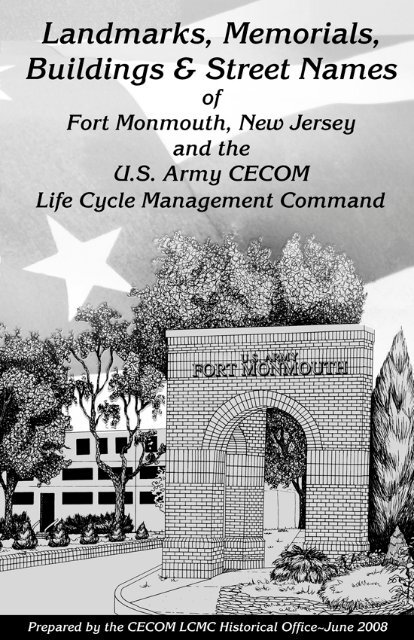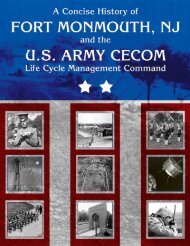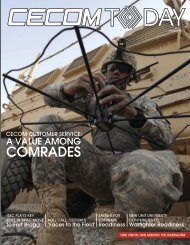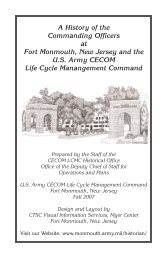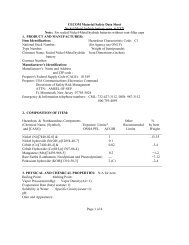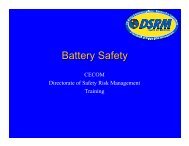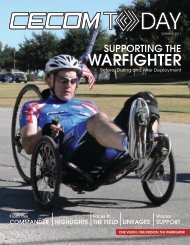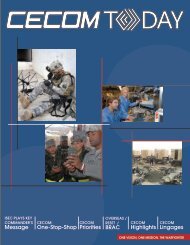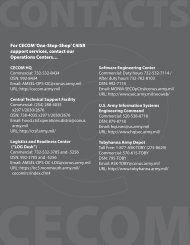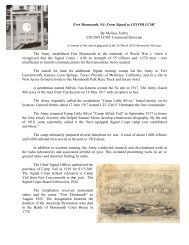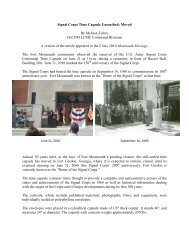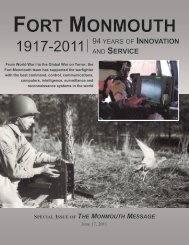Landmarks, Memorials, Buildings and Street Names of ... - CECOM
Landmarks, Memorials, Buildings and Street Names of ... - CECOM
Landmarks, Memorials, Buildings and Street Names of ... - CECOM
- No tags were found...
Create successful ePaper yourself
Turn your PDF publications into a flip-book with our unique Google optimized e-Paper software.
<strong>L<strong>and</strong>marks</strong>, <strong>Memorials</strong>,<strong>Buildings</strong> <strong>and</strong> <strong>Street</strong> <strong>Names</strong><strong>of</strong>Fort Monmouth, New Jersey<strong>and</strong> theU.S. Army <strong>CECOM</strong>Life Cycle Management Comm<strong>and</strong>Prepared by the Staff <strong>of</strong> the<strong>CECOM</strong> LCMC Historical OfficeOffice <strong>of</strong> the Deputy Chief <strong>of</strong> Staff forOperations <strong>and</strong> PlansU.S. Army <strong>CECOM</strong> Life Cycle Management Comm<strong>and</strong>Fort Monmouth, New JerseyJune 2008Design <strong>and</strong> Layout byCTSC Visual Information Services, Myer CenterFort Monmouth, New JerseyVisit our Website: www.monmouth.army.mil/historian/
CONTENTSSectionPageIntroduction(Previous Page)I. Main Post 1-29Parks <strong>and</strong> <strong>Memorials</strong> 1-8Main Gates 9<strong>Buildings</strong> 10-24<strong>Street</strong> <strong>Names</strong> 25-29II. 400 Area 30-32<strong>Buildings</strong> 30-31<strong>Street</strong> <strong>Names</strong> 32III. Charles Wood Area 33-38<strong>Buildings</strong> 33-36<strong>Street</strong> <strong>Names</strong> 36-38IV. Off Post 39-42Camp Coles/Coles Area 39<strong>CECOM</strong> Office Building 40Deal Test Site 40-41Diana Site 41Evans Area 42
Main PostNestled in Monmouth County, New Jersey, Fort Monmouth lies fiftymiles south <strong>of</strong> Manhattan, sixty miles northeast <strong>of</strong> Philadelphia <strong>and</strong>about five miles from the Atlantic Ocean. 1125.44 acres make up thepost, which includes hundreds <strong>of</strong> housing units, dozens <strong>of</strong> administrativebuildings, several laboratory buildings, <strong>and</strong> an eighteen-hole golfcourse. 636.10 <strong>of</strong> those 1125.44 acres comprise what is known as theFort’s “Main Post.” iThat l<strong>and</strong> once featured the MonmouthPark Racetrack, which flourishedbetween 1870 <strong>and</strong> 1893. ii Thegovernment first leased 468 acres <strong>of</strong> thesite in May 1917 from Melvin VanKeuren <strong>of</strong> Eatontown for use in trainingSignal Corps Soldiers en route toEurope. iii The Army considered the Old Monmouth Park Racetrack c.1873-1874l<strong>and</strong>, portions <strong>of</strong> which were in use as a potato farm at the time, idealas it was close to both river <strong>and</strong> rail transportation. iv The site initiallywas called “Camp Little Silver,” based merely on its location. Thecamp achieved semi-permanent status <strong>and</strong> the new name “CampAlfred Vail” on September 15, 1917, just three months after its establishment.Vail, an associate <strong>of</strong> telegraph inventor Samuel F. B. Morse,helped Morse to develop commercial telegraphy. The post operatedwith semi-permanent status until August 1925, when it was designateda permanent installation <strong>and</strong> was named Fort Monmouth. The namehonors the men <strong>and</strong> women <strong>of</strong> the American Revolution who died inthe Battle <strong>of</strong> Monmouth Court House in 1778. vParks <strong>and</strong> <strong>Memorials</strong>Cowan ParkCowan Park is located inside the East Gate nearRussel Hall. Dedicated on June 24, 1961 byGeneral Orders Number 48, Cowan Park memorializesCOL Arthur S. Cowan, who comm<strong>and</strong>edCamp Alfred Vail from September 16, 1917-June 28, 1918 <strong>and</strong> Fort Monmouth fromSeptember 2, 1929- April 30, 1937. COL Cowanconsolidated the Signal Corps Laboratories <strong>and</strong>is remembered for his astute leadership duringthe formative years <strong>of</strong> the Signal School. vi<strong>L<strong>and</strong>marks</strong> <strong>and</strong> Place <strong>Names</strong> at Fort MonmouthCOL Arthur S. Cowan
Husky Brook PondHusky Brook Pond is located near theNicodemus Gate. It underwent a massivecleanup from 1966 through the early1970s that sought to convert a ten-acrewastel<strong>and</strong> into a h<strong>and</strong>some, usefulrecreation area. Today, the area boastsseveral picnic sites <strong>and</strong> tranquil views. xiiHusky Brook PondJagger ParkJagger Park is located in the Officer Family Housing Area to the North<strong>of</strong> the East Gate entrance. Designated sometime prior to 1935, ithonors 1LT H.R. Jagger, 304th Field Signal Battalion, 79th Division,who died in action in France, 1918. xiiiMyer ParkSection III, General Orders Number 22,Headquarters Fort Monmouth, dated April 9, 1949designated the area east <strong>of</strong> Russel Hall <strong>and</strong> west <strong>of</strong>Oceanport Avenue as Myer Park. General OrdersNumber 48, dated 24 June 1961, later rescindedGO 22 <strong>and</strong> renamed the area Cowan Park. xivWhile assigned as an assistant surgeon in theRegular Army <strong>of</strong> the United States, Dr. Albert J.Myer devised a military visual signaling systemthat the Army then adopted in 1860. Dr. Myerbecame Signal Officer <strong>of</strong> the subsequently createdSignal Division, <strong>and</strong> received the rank <strong>of</strong> Major.On March 3, 1863, President Abraham Lincolnsigned legislation making the Signal Corps aseparate military branch. Major Myer became theMyer Park Memorial first Chief Signal Officer with the rank <strong>of</strong> Colonel.He continued to lead the Signal Corps for two <strong>and</strong> a half decades. xvSoldiers ParkSoldiers Park is located at the intersection <strong>of</strong>the Avenue <strong>of</strong> Memories <strong>and</strong> Wilson Avenue,opposite the Bowling Center. It honors “the FortMonmouth Soldiers <strong>and</strong> civilians who deployed<strong>and</strong> fought worldwide <strong>and</strong>…the families whokept the home fires burning bright.”<strong>L<strong>and</strong>marks</strong> <strong>and</strong> Place <strong>Names</strong> at Fort MonmouthDr. Albert J. MyerSoldiers Park
Van Kirk ParkDesignated by General Orders Number24, dated June 21, 1943, Van Kirk Parkis located between Brewer <strong>and</strong> MaltererAvenues (opposite the post fieldhouse). First Lieutenant John StewartVan Kirk Park MemorialVan Kirk died in combat on November 30, 1942 in Djedeida, Tunisia.He had previously attended Officer C<strong>and</strong>idate School at FortMonmouth. A memorial granite bench was erected at Van Kirk Parkwithout ceremony in the early 1950s pursuant to the wishes <strong>of</strong> thefather, the donor. The park also features the Purple Heart Memorial. xviVoris ParkVoris Park is located between Russel <strong>and</strong> AllenAvenues immediately west <strong>of</strong> Jagger Park in theOfficer Family Housing Area to the north <strong>of</strong> the EastGate entrance. Dedicated on September 27, 1957by General Order Number 76, the park honors COLAlvin C. Voris (1876-1952). Voris comm<strong>and</strong>ed thepost from April 30, 1937- August 1, 1938. xviiAugenstine MemorialThe Augenstine Memorial is located justsouth <strong>of</strong> Barker Circle. Dedicated in 1951,the bench <strong>and</strong> its plaque originally had abackground <strong>of</strong> three dogwood trees. Thebench memorializes Chief Warrant OfficerEdwin Daniel Augenstine, a native <strong>of</strong> WestLong Branch, NJ with over 17 years <strong>of</strong> ArmyAugenstine Memorial service. Augenstine served at FortMonmouth from 1936 to 1942, <strong>and</strong> then deployed to Europe <strong>and</strong>Manila. He died <strong>of</strong> an unknown tropical disease in November 1945. xviiAvenue <strong>of</strong> MemoriesThe monuments <strong>and</strong> trees lining the Avenue<strong>of</strong> Memories pay homage to the Signal CorpsSoldiers who gave their lives during WWII.The Army dedicated the Avenue on April 6,1949 when the first marker was placed inmemory <strong>of</strong> MAJ Edmund P. Karr. Originallydesignated as “Memorial Drive,” new markers<strong>and</strong> trees have been added over the years. xixCOL Alvin C. VorisAvenue <strong>of</strong> Memories <strong>Memorials</strong>3/4 .
On Memorial Day, 1999, the Fort Monmouth community re-affirmedits commitment to those Soldiers honored on the Avenue <strong>of</strong> Memories.Battle <strong>of</strong> the Bulge MonumentThis monument honors the men <strong>and</strong> women<strong>of</strong> the United States Armed Forces who participatedin the Battle <strong>of</strong> the Bulge. Dedicated onMay 6, 2001, it is located at the intersection <strong>of</strong>Wilson Avenue <strong>and</strong> the Avenue <strong>of</strong> Memories(diagonal to the Bowling Center). xxBreslin War MemorialBattle <strong>of</strong> the Bulge MonumentBreslin War MemorialCentennial Time CapsuleThe Breslin War Memorial resides just inside theCommunity Center’s fence. Dedicated at FortMonmouth on April 25, 1961, the stonemonument memorializes those service members“who did not return” from war. Two privatecitizens, Pat <strong>and</strong> S<strong>and</strong>y Breslin, originally erectedthe memorial on private property. After losingtheir lease, the memorial sat in storage untilcoming to its resting place, here. xxiThe U.S. Army Signal Corps Centennial TimeCapsule installation ceremony occurred in front <strong>of</strong>Russel Hall on September 16, 1960, tocommemorate the firstcentennial <strong>of</strong> the Corps. TheCapsule is to be opened June21, 2060. It contains itemsTime Capsule Ceremonydepicting the status <strong>of</strong> militarycommunications in 1960, as well as historicalmaterial showing the origins <strong>of</strong> the Corps <strong>and</strong>progress made during its first hundred years. xxiiTime Capsule InscriptionD-Day MemorialThe D-Day Memorial commemorates the40th Anniversary <strong>of</strong> D-Day <strong>and</strong> is located infront <strong>of</strong> the Van Deusen Library. Thisdedication occurred on June 6, 1984. xxiii<strong>L<strong>and</strong>marks</strong> <strong>and</strong> Place <strong>Names</strong> at Fort MonmouthD-Day Memorial
Holocaust MemorialThe Holocaust Memorial Garden is located to the right<strong>of</strong> the Main Post chapel when you are facing thatbuilding. Jewish War Veterans donated <strong>and</strong> planted atree there in 1992. The next year, they added a plaqueat the base <strong>of</strong> the tree. xxiv A sculpture for the MemorialGarden, created by BrianHolocaust SculptureHanlon <strong>and</strong> donated by theJewish Federation <strong>of</strong> Greater MonmouthCounty, was unveiled on the day <strong>of</strong> the post’s2005 Holocaust Remembrance Program. xxvHolocaust MemorialHowitzersThere are two historic Howitzer guns on the grounds <strong>of</strong> the U.S. MilitaryAcademy Preparatory School (USMAPS; <strong>of</strong>f <strong>of</strong> Abbey Road). xxviiKain MemorialKain MemorialMudd MemorialThe Kain Memorial is located near Building 1104,behind Soldiers Park. It memorializes Wesley L.Kain, who died in action on December 16, 1944.Originally located in Brooklyn, NY, thedeceased’s family requested that it be movedhere in September 1994. xxviiThe Fort Monmouth community dedicated a mapletree <strong>and</strong> plaque in front <strong>of</strong> Russel Hall (GarrisonHeadquarters) on August 31, 2007 in memory <strong>of</strong>former Garrison Chief <strong>of</strong> Staff George W. Mudd “forhis faithful service to Fort Monmouth-1975-2003.” xxviiiPigeon MemorialMudd MemorialThe birdbath Pigeon Memorial was located on theeast side <strong>of</strong> Malterer Ave. near buildings 550 <strong>and</strong>551. It stood in what was then a wooded area incommemoration <strong>of</strong> the winged couriers who “got themessage through” during WWI, WWII, <strong>and</strong> Korea.The Signal Corps Pigeon Breeding <strong>and</strong> TrainingPigeon Memorial5/6 .
Section was located here from 1919-1957 to prepare those birds forwar. Fort Monmouth dedicated the memorial on July 14, 1960, as apart <strong>of</strong> the post’s celebration <strong>of</strong> the U.S. Army Signal CorpsCentennial. xxix The Memorial has subsequently been removed.Purple Heart MemorialThe Purple Heart Memorial honors therecipients <strong>of</strong> the nation’s oldest militarydecoration. It resides in Van Kirk Park <strong>and</strong>was dedicated c. 2004. xxxRodman GunsPurple Heart MemorialRodman Guns InscriptionAt Fort Hancock, the guns were located west<strong>of</strong> <strong>and</strong> across the road in front <strong>of</strong> OfficersRow Quarters No. 12, the Comm<strong>and</strong>ingOfficer’s Quarters. There, they served aslawn ornaments to mark the Comm<strong>and</strong>ingOfficer's residence for many years. xxxiiThe two Rodman guns located in Cowan Parkare the only two 8" Rodman guns in the U.S.Army Museum System worldwide. xxxiiThey came to Fort Monmouth from FortHancock on nearby S<strong>and</strong>y Hook in the spring <strong>of</strong>1950, as Fort Hancock closed for the first time.Spanish American War MemorialRodman GunsThe granite Spanish American War Memorial is located in DunwoodyPark. The U.S. Veteran Signal Corps Association, Spanish War Divisionpresented it to Fort Monmouth at their 50thAnnual Reunion on September 22, 1950. Themonument memorializes the <strong>of</strong>ficers <strong>and</strong>men <strong>of</strong> the Regular <strong>and</strong> Volunteer SignalCorps, U.S. Army, who established <strong>and</strong>maintained communications throughout theSpanish-American War, the PhilippineInsurrection, <strong>and</strong> the China Relief Expedition. xxxiiiSpanish American War MemorialUSMAPS MemorialA large memorial on the grounds <strong>of</strong> the U.S. Military AcademyPreparatory School (<strong>of</strong>f <strong>of</strong> Abbey Road) memorializes those<strong>L<strong>and</strong>marks</strong> <strong>and</strong> Place <strong>Names</strong> at Fort Monmouth
cadets lost in times <strong>of</strong> war with a list <strong>of</strong> thosekilled in each war. xxxivVietnam <strong>Memorials</strong>The post features two Vietnam veterans’USMAPS Memorial memorials. The entrance to the nature walkacross the street from Building 977 <strong>and</strong> behind Gosselin FamilyHousing features a plaque reading, “Dedicated to the men <strong>and</strong> womenwho served during the Vietnam War, 1959-1975.” The nature walk wasdedicated in the Spring <strong>of</strong> 2001. xxxvThe Defense <strong>of</strong> Freedom Memorial is located in front<strong>of</strong> Building 1207 along the Avenue <strong>of</strong> Memories. Itlists the names <strong>of</strong> Soldiers killed in Vietnam, <strong>and</strong>was dedicated sometime during that War.WWII MemorialWWII MemorialThe WWII Memorial is located at thenorthern border <strong>of</strong> Greely Field. It honorsthose members <strong>of</strong> the Signal Corps whogave their lives during WWII, <strong>and</strong> wasdedicated at the celebration <strong>of</strong> the 35thAnniversary <strong>of</strong> Fort Monmouth onOctober 4, 1952. xxxvi A large number <strong>of</strong>donors contributed to the building <strong>of</strong> themonument, including relatives <strong>and</strong>friends <strong>of</strong> the honored dead, <strong>and</strong> members <strong>of</strong> Fort Monmouth <strong>and</strong>other Signal Corps installations.Wright MemorialThe 10th Field Signal Battalion Association<strong>and</strong> the 7th Division Association <strong>of</strong> WWIveterans dedicated a beech tree <strong>and</strong> plaque totheir founder, E. Frederic Wright (1899-1974),on May 21, 1977. The memorial is locatedbehind the Comm<strong>and</strong>ing General’s Residence.Vietnam MemorialWright MemorialThe 10th Field Signal Battalion organized at Fort Monmouth, thencalled Camp Alfred Vail, on July 10, 1917. The Battalion was assignedto the 7th Division on December 6, 1917 <strong>and</strong> departed from this installationon August 17, 1918. It saw front line action in France fromOctober 8 to November 11, <strong>and</strong> had its colors decorated byGEN John J. Pershing.7/8 .
<strong>Buildings</strong>Abramowitz Hall (Building 114)Abramowitz Hall, also knownas the Athletic Center or FieldHouse, serves as FortMonmouth’s Physical FitnessCenter. Dedicated on June 7,1985, the building honorsLieutenant Colonel ReubenAbramowitz Hall (Building 114)Abramowitz, who served atFort Monmouth as a radio instructor. It is said thatLTC Abramowitz’s innovative methods <strong>of</strong> trainingradio operators influenced every man trained during<strong>and</strong> after World War II. xxxixBuilding 125: Dir. <strong>of</strong> Information ManagementBuilding 126: Guard Shelter, East GateBuilding 167: Department <strong>of</strong> Public WorksBuilding 173: Department <strong>of</strong> Public WorksBuilding 196-199: Space <strong>and</strong> Terrestrial Communications Directorate(S&TCD)Barker CircleLTC Reuben AbramowitzBarker Circle was named in 1942 after aU.S. Military Academy cadet killed in atraining accident. xlEnlisted barracks <strong>Buildings</strong> 205-208were constructed in 1927 on what wouldbecome Barker Circle. These representthe first permanent buildings constructedBarker Circleat Fort Monmouth. National HistoricReports show that “the buildings are T-shaped <strong>and</strong> constructed usinga concrete structural system faced in brick veneer. The barracks arethree stories tall with a full three-story porch supported by concretepiers that span the main facade. Building 207 was enlarged on thenorth end to accommodate the Army Post Bank. A fifth barracks(Building 287, now vacant) was added to the complex in 1940 <strong>and</strong> issimilar to the first four. In 1958, the original slate ro<strong>of</strong>s were replacedwith asphalt-shingled ro<strong>of</strong>s. Alterations consist <strong>of</strong> exterior staircasesthat have been added to each end <strong>of</strong> the barracks buildings <strong>and</strong> thereplacement <strong>of</strong> windows.” xli Building 205, once the Women’s Army9/10 .
Corps (WAC) detachment barracks, is now occupied by theDepartment <strong>of</strong> Public Works. xlii Building 206, once occupied by theMilitary Police Detachment, currently houses the Directorate forResource Management. Building 207, once occupied by the 389thArmy B<strong>and</strong>, currently houses U.S. Military Academy (USMA) CadetC<strong>and</strong>idate Barracks; xlivBuilding 208, Barnes Hall, currently st<strong>and</strong>s vacant. The building oncehoused Headquarters, Special Troops. Dedicated on February 7, 1951by General Orders Number 15, this building honors SGT Will C.Barnes, Signal Corps. SGT Barnes received the Medal <strong>of</strong> Honor forbravery in action at Fort Apache, AZ, on September 11, 1881. xlvAllison Hall (Building 209)Allison Hall once housed the first permanent hospitalbuilding, the U.S. Army Management Agency, <strong>and</strong>the Satellite Communications Agency. It currentlyhouses the Program Manager for DefenseCommunications <strong>and</strong> Army Transmission Systems(PM DCATS). It resides in the NE corner <strong>of</strong> the MainPost at the intersection <strong>of</strong> Barton <strong>and</strong> Allen Avenuesin the Historic District.National Historic Reports show that this “Hshapedbuilding…was constructed in twophases: the main block <strong>and</strong> the east wingwere completed in April 1928, <strong>and</strong> the westwing <strong>and</strong> rear wings were completed in1934. The building rises two stories <strong>and</strong>Allison Hall (Building 209)utilizes a concrete structural system clad inbrick veneer. The front entry is delineated by a concrete porticoornamented with columns <strong>and</strong> a balustrade. The original sun porcheslocated on the end <strong>of</strong> each ward have been enclosed to provide <strong>of</strong>fices.Original windows have been replaced.”General Orders Number 92, dated September 25, 1961, dedicatedAllison Hall for Major General James B. Allison, who comm<strong>and</strong>ed FortMonmouth from 1925-1926, <strong>and</strong> served as Chief Signal Officer <strong>of</strong> theArmy from 1935-1937. xlviBuilding 210:Officer HousingSpace <strong>and</strong> Terrestrial Communications Directorate (S&TCD)Officer housing is located north <strong>of</strong> Greely Field, “lining Russel <strong>and</strong>Allen Avenues <strong>and</strong> surrounding a l<strong>and</strong>scaped open space known as<strong>L<strong>and</strong>marks</strong> <strong>and</strong> Place <strong>Names</strong> at Fort MonmouthCOL James B. Allison
Blair Hall (Building 259)Blair Hall, dedicated March 4, 1969,memorializes Fort Monmouth scientist <strong>and</strong>inventor COL William R.Blair. l COL Blair posthumouslyentered the NewJersey Inventor’s Hall <strong>of</strong>Fame in 2004. He isconsidered the father <strong>of</strong>American radar. liBlair Hall (Building 259)Scoutinggroups now use the building as a meeting facility.COL William R. BlairAdditional Officer Housing<strong>Buildings</strong> 261-269 were constructed between 1929 <strong>and</strong> 1932 as fourfamilyapartment buildings for student <strong>of</strong>ficers. National HistoricReports show that “the buildings are laid out in two rows with a servicelane between the rows to provide access to garages. The buildings aretwo-story with paired central entrances. Each pair <strong>of</strong> entry doorsshares a covered stoop that features simple trim <strong>and</strong> GeorgianColonial Revival detailing.” liiScriven Hall (Building 270)Scriven Hall, completed in 1929, is locatedon Allen Avenue near Officer FamilyHousing. Today, it serves as BachelorOfficers’ Quarters, but it once housed theFort Monmouth Officers Club <strong>and</strong> NCOOpen Mess. Per General Orders Number 46,Scriven Hall (Building 270)dated June 15, 1950, Scriven Hallmemorializes Brigadier General George P. Scriven, Chief Signal Officerfrom 1913-1917. BG Scriven pioneered thedevelopment <strong>of</strong> the Army Air Service. liiiBG George P. ScrivenNational Historic Reports show that Building 270 wasbuilt “<strong>of</strong> concrete block <strong>and</strong> faced with red brick. Ithas a hipped ro<strong>of</strong> <strong>and</strong> hipped dormers, <strong>and</strong> a onestoryporch that spans three-quarters <strong>of</strong> the facade<strong>and</strong> is ornamented with wood balustrades.” liv<strong>L<strong>and</strong>marks</strong> <strong>and</strong> Place <strong>Names</strong> at Fort Monmouth
Gardner Hall (Building 271)These Bachelors Officers’/ Visitors’ Quarterswere constructed in October 1931 <strong>and</strong>dedicated for BG John Henry Gardner on June5, 1945. Gardner’s Army career includedservice as Director <strong>of</strong> the Aircraft SignalService <strong>and</strong> as Assistant Chief, Procurement<strong>and</strong> Distribution Service, Office <strong>of</strong> the ChiefSignal Officer. lvGardner Hall (Building 271)National Historic Reports show that, like Building 270, Building 271was built “<strong>of</strong> concrete block <strong>and</strong> faced with red brick. It has a hippedro<strong>of</strong> <strong>and</strong> hipped dormers, <strong>and</strong> a one-story porch that spans threequarters<strong>of</strong> the facade <strong>and</strong> is ornamented with wood balustrades.” lviBuilding 273: Gas StationKaplan Hall (Building 275)Once the site <strong>of</strong> the post theater, Kaplan Hallhas housed the U.S. Army CommunicationsElectronics Museum since 1982. It wasconstructed in 1933 with funds from the ArmyMotion Picture Service.National Historic Reports show that the edificeKaplan Hall (Building 275)“is a brick building accented by brick quoins<strong>and</strong> a pedimented front gable ro<strong>of</strong>. Minor exterior alterations to theoriginal design include the brick infill <strong>of</strong> a front facade window <strong>and</strong> theremoval <strong>of</strong> the ticket kiosk from the front entrance.”Building 275 was dedicated for MAJ Benjamin Kaplan (1902-1952)on December 21, 1953 by General Orders Number 221. As postengineer, Major Kaplan oversaw construction <strong>of</strong> what is now known asthe Historic District. lvii A plaque reading “A Memorial to HomingPigeons In Combat Courage • Loyalty • Endurance” is affixed to thebuilding.Quartermaster Support AreaNational Historic Reports show that “in the original design <strong>of</strong> thepermanent facility, the quartermaster support area was separated fromthe main cantonment area… The buildings encompassed in this areawere constructed to house the provisioning <strong>and</strong> maintenance functionsfor the installation.”13/14 .
Squier Hall (Building 283)Squier Hall also comprises part <strong>of</strong> theHistoric District <strong>and</strong> was completed in March1935. Located on Sherrill Drive behind theMcAfee Center, the building now houses theProgram Executive Office for EnterpriseInformation Systems (PEO EIS) <strong>and</strong> theDefense Information Systems Agency(DISA). The building previously housed theSquier Hall (Building 283)headquarters <strong>of</strong> the Signal CorpsEngineering Laboratory (from 1945-1955) <strong>and</strong> the AcademicBuilding, Officers’ Department, the Signal School. lixNew York architects Rodgers <strong>and</strong> Poor designed Squier Hall. NationalHistoric Reports show that the L-shaped building “consists <strong>of</strong> tw<strong>of</strong>unctional parts: an administration <strong>and</strong> laboratory section <strong>and</strong> a rearshop section. The administration section <strong>of</strong> the building is two stories<strong>and</strong> has a steel structural frame faced in brick veneer. The front facadeis characterized by the entrance portico that is composed <strong>of</strong> two-storyconcrete piers faced in brick. The windows are b<strong>and</strong>s <strong>of</strong> hopperwindows. The shop section is located in the rear <strong>of</strong> the building <strong>and</strong> isconstructed with a steel frame, brick veneer, <strong>and</strong> industrial sawtoothro<strong>of</strong>. The laboratory was enlarged in 1947 <strong>and</strong>, again, in 1958.” lxInitially known simply as the “Fort Monmouth SignalLaboratory,” War Department General OrdersNumber 49 designated Building 283 as the “SquierSignal Laboratory” on June 28, 1945. FortMonmouth General Orders Number 79, dated July19, 1955, later redesignated the building “SquierHall.” Both designations honor Major GeneralGeorge Owen Squier, Chief Signal Officer, 1917-MG George Owen Squier1923. MG Squier is credited with inventing the“wired wireless” basis for the modern carrier system. lxiRussel Hall (Building 286)Russel Hall was built in the 1930s as a Headquarters building for the post.Philadelphia architect Harry Sternfield designed the building, whichwas completed in 1936 in collaboration with the Office <strong>of</strong> theConstructing Quartermaster. National Historic Reports show that “It isan Art Deco building composed <strong>of</strong> a four-story central pavilion <strong>and</strong>three-<strong>and</strong>-a-half story flanking wings. The central portion is faced15/16 .
Fort Monmouth re dedicated the building on June 19,1998, at which point COL Smarr’s family received thePOW Medal, posthumously. lxviBuilding 292:Building 293:Building 295:Building 296:Building 359:902nd Military Intelligence Group;956th Transportation Company; StorageLRC Power Sources Branch BatteryTest FacilityLogistics <strong>and</strong> Readiness CenterProject Manager Signals WarfarePM DCATSBlack Hall (Building 360)These distinguished VisitorsQuarters were completed in1956 <strong>and</strong> dedicated by GeneralOrder 45 on June 28, 1957.They memorialize BG Garl<strong>and</strong> C.Black, who l<strong>and</strong>ed at Norm<strong>and</strong>yas General Bradley’s 12th ArmyBlack Hall (Building 360)BG Garl<strong>and</strong> C. BlackGroup Signal Officer <strong>and</strong>received numerous commendations. The building has also served asBachelors Quarters <strong>and</strong> a guesthouse. It is located inside the East Gateon the south side <strong>of</strong> Allen Avenue near the Officer Family Housing. lxviiBijur Hall (Building 361)Bijur Hall functions as senior enlisted quarters. Itwas built <strong>and</strong> dedicated to CPT Arthur H. Bijur(1919-1945) per General Orders Number 19,dated July 12, 1965. CPT Bijur died in action onJanuary 14, 1945 on Luzon Isl<strong>and</strong>, PhilippineIsl<strong>and</strong>s, after he climbed from a foxhole to warnhis men <strong>of</strong> impending enemy fire. Assigned toBijur Hall (Building 361)the 43rd Signal Company at the time <strong>of</strong> hisdeath, he had previously trained at Fort Monmouth. Bijur Hall islocated inside the East Gate on the north side <strong>of</strong> Allen Avenue near theOfficer Family Housing. lxviiiMoorman Hall (Building 362)Building 362 serves as Bachelor Officers’Quarters. It was built in 1965 <strong>and</strong> named for WWIera Signal Corps <strong>of</strong>ficer Frank Moorman in 1967.In addition to his distinguished military career,COL Albert W. SmarrMoorman Hall (Building 362)17/18 .
Frank Moorman fathered MG Frank W. Moorman, who latercomm<strong>and</strong>ed Fort Monmouth from 1963- 1965. lxix Moorman Hall islocated inside the East Gate on the north side <strong>of</strong> Allen Avenue near theOfficer Family Housing tennis courts.Building 363:Building 364:Building 365:guest housingguest housingguest housingBuilding 500: Chapel (Malterer Ave), built 1962Building 501: Administrative space, formerly the site <strong>of</strong> Social Work<strong>and</strong> Mental Health Services (moved to Building 1075)Van Deusen Library (Building 502)Chapel (Building 500)The Van Deusen Library commemorates the 37-year Army career <strong>of</strong> MG George Lane Van Deusen.MG Van Deusen graduated from the U.S. MilitaryAcademy in 1909 as president <strong>of</strong> his class. Heserved in various capacities at Fort Monmouth, hislast being that <strong>of</strong>Comm<strong>and</strong>ing General <strong>of</strong>the Eastern SignalCorps Training CenterBG George L. Van Deusen(1942-1945). Thebuilding was dedicated on June 21, 1977,the 117th anniversary <strong>of</strong> the United States Van Deusen Library (Building 502)Signal Corps. lxxBuilding 550:Project Manager Distributed Common GroundSystem, Army (PM DCGS; once the post library)Armstrong Hall (Building 551)Major Edwin HowardArmstrongArmstrong Hall, once home to the Signal Corpsmuseum, now serves as the Education Center <strong>of</strong> FortMonmouth. lxxi The Deputy Chief <strong>of</strong> Staff for Personnel(DCSPER), Human Resources, Army ContinuingEducation, <strong>and</strong> the LearningResource Center residethere. Per General OrdersNumber 51, dated May 31,1955, the building memorializesMajor Edwin Howard Armstrong, ascientist <strong>and</strong> Soldier <strong>of</strong> the U.S. ArmyArmstrong Hall (Building 551)<strong>L<strong>and</strong>marks</strong> <strong>and</strong> Place <strong>Names</strong> at Fort Monmouth
Signal Corps. Much <strong>of</strong> his work concentrated on the development <strong>of</strong>FM radio technology. lxxii Major Armstrong, who held 42 patents,allowed the free use <strong>of</strong> them by the Army during World War II.Building 552: Community Center (the original recreation hall)Building 555: Readiness Directorate, LRC (once the post theater)Building 563: PM Combat IDBuilding 566: Recruitment Comm<strong>and</strong>McAfee Center (Building 600)McAfee Center (Building 600)The McAfee Center,Building 600, housesthe Intelligence <strong>and</strong>Information WarfareDirectorate (I2WD) <strong>of</strong>the Communications-Electronics Research, Development, <strong>and</strong>Engineering Center (CERDEC). It islocated on Sherrill Avenue. Dedicated onJuly 28, 1997, the Center honors renowned physicist Dr. WalterMcAfee. Dr. McAfee held numerous supervisory positions during his42 years at Fort Monmouth, <strong>and</strong> participated in the now-famous DianaProject that resulted in our first contact with the moon. lxxiiiBuilding 601-4: 2WD Laboratory, Warehouse, <strong>and</strong> StorageBuilding 616: Garrison Administrative SpaceBuilding 671: Fort Dix Criminal Investigation DivisionBuilding 675-8: I2WD Administrative SpaceBuilding 682: U.S. Army Military AffiliateRadio System StationBuilding 686: Thrift ShopBuilding 689: Bowling CenterBuilding 699: Auto Repairs, gas stationLane Hall (Building 702)Dr. Walter McAfeeBowling Center (Building 689)Lane Hall (Building 702)Lane Hall functions as the CommunityActivity Center. Fort Monmouth dedicatedthe building in 1983, after the old EnlistedMess Hall that had originally memorializedLane (dedicated in 1950) was razed. LaneHall memorializes Private Second ClassMorgan D. Lane, the first member <strong>of</strong> theSignal Corps to receive the Medal <strong>of</strong> Honor.19/20 .
PVT Lane fought with the Union Army during the Civil War <strong>and</strong> wasrewarded for capturing the Confederate Flag from the GunboatNansemond near Jetersville, Va. lxxivBuilding 750:Building 755:Building 761:Building 788:Building 789:Building 790:Transportation Motor PoolGuard ShackEqual Employment Opportunity (EEO)Administrative SpaceDCSPER ClassroomGarrison Base Realignment <strong>and</strong> Closure (BRAC) OfficeGuard ShackBuilding 800: PM Aerial Common Sensor (ACS) Administrative SpaceBuilding 801: Gear to Go (outdoor recreation center)/PM ACS Administrative SpaceBuilding 810: Veterinarian Treatment FacilityBuilding 812: Army Community Services, dedicated Nov. 18, 1986 lxxvBuilding 814-21:USMAPS Athletic FacilitiesBuilding 822: Burger KingBuilding 826: Internal Review Office Administrative SpaceBuilding 901: Deputy Chief <strong>of</strong> Staff for PersonnelBuilding 906: S&TCD, PM Warfighter Info. Network Tactical (WIN-T)Building 909-18:PM WIN-TBuilding 975: Warehouse; once the Quartermaster’s Warehouse lxxviBuilding 976: Storage; once occupied by the Cold Storage Plant lxxviiBuilding 977: Department <strong>of</strong> Public Safety; once the Guard House lxxviiBuilding 983: Dog KennelBuilding 1000: Post ExchangeBuilding 1001: Shopping Center, Four SeasonsBuilding 1002: Postman Plus/Specialty Shop/Concession ShopBuilding 1003: Optical Shop/Flower ShopBuilding 1005: Post OfficeBuilding 1006: First Atlantic Federal Credit UnionBuilding 1007: CommissaryBuilding 1010: Morale, Welfare, <strong>and</strong> Recreation Tickets <strong>and</strong> ToursPatterson Army Health Clinic (Building 1075)Medical care at Patterson Army Health Clinic (PAHC) has beenavailable in one form or another since 1958, <strong>and</strong> continues today asan integral part <strong>of</strong> the operation <strong>of</strong> Fort Monmouth. PAHC providesambulatory <strong>and</strong> preventive health care services to approximately10,000 eligible beneficiaries. Located in Building 1075, PAHC seesapproximately 120 patients per working day. The primary focus <strong>of</strong><strong>L<strong>and</strong>marks</strong> <strong>and</strong> Place <strong>Names</strong> at Fort Monmouth
Patterson Army Health Clinic (Building 1075)PAHC is to increase the health <strong>and</strong>wellness <strong>of</strong> the population throughpreventive health services. PAHC alsosupports two outlying health clinics:Ainsworth U.S. Army Health Clinic, FortHamilton, NY <strong>and</strong> the Mills TroopMedical Clinic, Fort Dix, NJ.The present facility was opened <strong>and</strong> dedicated in1958. General Order 40, dated April 24, 1958,named it in honor <strong>of</strong> Major General Robert UriePatterson, United States Army Medical Corps(1877-1950). After completing medical studies atMcGill University, MG Patterson graduated withhonors from the Army Medical School in 1902. Hereceived two Silver Stars for conspicuous gallantryin action in the Philippines. During World War I, theMG Robert Urie PattersonBritish, Italian, Czechoslovakian <strong>and</strong> Serbiangovernments all decorated MG Patterson. He also received theDistinguished Service Medal. During the postwar years, hisassignments included Instructor, U.S. Army War College; GeneralStaff, War Department; Medical Director, U.S. Veteran’s Bureau;Executive Officer, Office <strong>of</strong> the Surgeon General <strong>and</strong> Comm<strong>and</strong>er <strong>of</strong>the Army <strong>and</strong> Navy Hospital, Hot Springs, Arkansas. He served afour-year term as Surgeon General <strong>of</strong> the Army <strong>and</strong> retired in 1935.Major General Patterson died on December 6, 1950. lxxixThe new Fort Monmouth Community-Based Outpatient Clinic (CBOC)opened on July 21, 2004. The CBOC encompasses 6,200 square feeton the third-floor wing <strong>of</strong> the Fort Monmouth Patterson Army HealthClinic. It is expected to accommodate about 10,000 visits per year. lxxxThere is a plaque by the Primary Care Clinic entrance to the buildingfor Medical Department Activity Soldiers who served in Desert Storm.Building 1077-8:HousingBuilding 1102: Intelligence, Electronic Warfare <strong>and</strong> SensorsLaboratory/StorageBuilding 1103: Union Hall/ Administrative SpaceBuilding 1104: Project Manager Signals Warfare Administrative SpaceBuilding 1105: Legal Services/Inspector General Administrative SpaceBuilding 1107: Union Meeting SpaceBuilding 1108: Fort Dix Criminal Investigation DivisionBuilding 1123: Military Pay <strong>and</strong> IdentificationBuilding 1124: Car Wash21/22 .
Vail Hall (Building 1150)Vail Hall houses the Directorate <strong>of</strong>Information Management (DOIM) <strong>and</strong> theInformation Technology ServicesDirectorate (ITSD). The building wasconstructed in 1952 <strong>and</strong> per GeneralOrders Number 19, dated June 21, 1956,Vail Hall (Building 1150)memorializes Alfred Vail (1807-1859), thedistinguished New Jersey inventor whose great mechanical <strong>and</strong>financial contributions to wire communications substantiallyaccelerated the first experiments in telegraphy. Vail was a closeassociate <strong>of</strong> Samuel Morse. lxxxi1200 AreaThe 1200 Area features the barracks <strong>and</strong>classroom buildings originally constructedfor the Signal School in 1953. “Backfill”following the departure <strong>of</strong> the Signal Schoolincluded the Military Academy PreparatorySchool (1975), the Chaplain Center <strong>and</strong>School (1979-1996),1200 Areathe 513th MilitaryIntelligence Brigade, (1982-1993), <strong>and</strong> theFederal Bureau <strong>of</strong> Investigation’s regionalcomputer support center. The location was rehabilitatedin 1996 to house elements <strong>of</strong> the U.S.Military Academy Prep School Army Electronics Comm<strong>and</strong> (<strong>CECOM</strong>).Building 1200: Comm<strong>and</strong> <strong>and</strong> Control Systems- Avionics, LRCBuilding 1201: Intelligence, Electronic Warfare <strong>and</strong> Sensors, LRCBuilding 1202: Communications Directorate, LRCBuilding 1203: Federal Bureau <strong>of</strong> Investigation (FBI)Building 1204-05:United States Military Academy PreparatorySchool (USMAPS)Pruden Auditorium (Building 1206)Pruden Auditorium was dedicated in 1987 to LTCAldred A. Pruden, an Army Chaplain who fought forthe right to wear his rank insignia (which was againstArmy policy). Pruden also planned <strong>and</strong> organized theArmy’s first training school for chaplains. lxxxii<strong>L<strong>and</strong>marks</strong> <strong>and</strong> Place <strong>Names</strong> at Fort MonmouthLTC Aldred A. Pruden
Building 1218: Directorate <strong>of</strong> Information ManagementBuilding 1228: Guard Shack<strong>Street</strong> <strong>Names</strong>, Main PostTechnician Fifth Grade Claude W. Abbey, 90th Signal Company, died inFrance on November 10, 1944 from wounds received the previous dayin combat. He posthumously received the Silver Star for gallantry inaction. General Order 10, dated May 7, 1956, designated the Avenue. lxxxviIn 1859, LT E. P. Alex<strong>and</strong>er helped General Myer demonstrate his system<strong>of</strong> visual signaling between Fort Hamilton, S<strong>and</strong>y Hook, <strong>and</strong> Twin Lights.At the outbreak <strong>of</strong> war, Alex<strong>and</strong>er joined the Confederate Army <strong>and</strong>became its first Chief Signal Officer (as a Brigadier General). lxxxviiAs Chief Signal Officer, 1906-1913, BG JamesAllen established the Army Air Service. Hepurchased the first military plane, built by the WrightBrothers. lxxxviii During the Spanish-American War,Allen established the first telegraph link between theU.S. <strong>and</strong> its forces in Cuba.General Order 22, April 9, 1949, <strong>and</strong> General Order31, December 7, 1949, designated the Avenue <strong>of</strong>BG James Allen Memories in honor <strong>of</strong> the <strong>of</strong>ficers <strong>and</strong> men <strong>of</strong> theSignal Corps who gave their lives during World War II in the service <strong>of</strong>their country. The Avenue <strong>of</strong> Memories turns into Tinton Avenueimmediately outside the main gate. lxxxixCadet Ernest S. Barker, United States Military Academy, died in 1942during a training flight accident at West Point. General Order 56,December 2, 1942, designated Barker Circle.LTC David B. Barton (1901-1944) was the Assistant Director <strong>of</strong>Training Literature at Fort Monmouth in 1943. He died in action in Italyin early 1944. xcBennet[No information currently available]COL John H. Brewer, a 1924 graduate <strong>of</strong> the United States MilitaryAcademy <strong>and</strong> a 1933 graduate <strong>of</strong> the Signal School Officers Course,died on or about May 12, 1943 during an airplane flight over NewGuinea. General Orders Number 24, dated June 21, 1943, designatedBrewer Avenue. xci<strong>L<strong>and</strong>marks</strong> <strong>and</strong> Place <strong>Names</strong> at Fort Monmouth
BG John J. CartyBG John J. Carty, Signal Reserve, served duringWorld War I as Director <strong>of</strong> Wire Communications forthe Allied Expeditionary Forces. He received theDistinguished Service Medal. xciiSGT Albert H. Cockayne died in 1900 during thePhilippine Insurrection when he <strong>and</strong> an assistantattempted, without escort, to repair a telegraph linecut by insurgents. xciiiCrystal Avenue commemorates the 1948 production, here at FortMonmouth, <strong>of</strong> the first synthetically produced large quartz crystals.The crystals were used in the manufacturing <strong>of</strong> electroniccomponents, <strong>and</strong> made the U.S. largely independent <strong>of</strong> foreignimports for this critical mineral.CPL Howard P. De Rum, 102nd Field Signal Battalion, died in actionnear Ronssoy, France on September 29, 1918. He posthumouslyreceived the Distinguished Service Cross for extraordinary heroism inaction. General Orders Number 7, dated May 7, 1956, designated DeRum Avenue. xcivEcho Avenue is located between Tindall <strong>and</strong> Cockayne Avenues <strong>and</strong>runs parallel to Todd Avenue.MAJ Hamilton H. T. Glessner fought in World War I <strong>and</strong> served asSignal Officer in the Panama Canal Department. He died in the CanalZone on January 15, 1937.First Sergeant Alex<strong>and</strong>er Gosselin, 2nd Field Signal Battalion,received the Distinguished Service Cross xcv on December 4, 1918 forheroism during the Meuse-Argonne <strong>of</strong>fensive.As a lieutenant, MG Adolphus W. Greely led the 1881-1884 SignalCorps Meteorological Expedition to the Arctic. As Chief Signal Officerfrom 1887-1906, Greely oversaw, during the Spanish-American War,the installation <strong>and</strong> operation <strong>of</strong> telegraph communications throughoutPuerto Rico, Cuba, <strong>and</strong> the Philippine Archipelago. He received theCongressional Medal <strong>of</strong> Honor on his 91st birthday, March 27, 1935. xcviHeliograph <strong>Street</strong> is named for the heliograph, an apparatus fortelegraphing by means <strong>of</strong> the sun's rays flashed from a mirror.The heliport is located <strong>of</strong>f Wallington Avenue in the northeast corner<strong>of</strong> Greely Field.25/26 .
CPL Hildreth, 4th Field Signal Battalion, was wounded during WorldWar I in the Battle <strong>of</strong> the Marne. Having received first aid, he returnedto the field only to die in h<strong>and</strong>-to-h<strong>and</strong> combat. xcviiCOL Jack Irwin enlisted in the Ohio National Guard on June 19, 1916.Having served in the Signal Corps from July 1931 to April 1936, Irwindied in action during World War II. General Order 42, November 30,1945, designated Irwin Avenue.PVT Morgan D. Lane was the Signal Corps' first Medal <strong>of</strong> Honor winner,having merited the award for capturing a Confederate Flag from theGunboat Nansemond, near Jetersville, Virginia.LT James B. Lockwood, until his death, was second in comm<strong>and</strong> <strong>of</strong>Greely's 1881-1884 expedition to the Arctic. Lockwood Isl<strong>and</strong>, whichhe discovered in 1882, was then the Nation's northernmost outpost. xcviiiCPT John A. Malterer was noted for his contributions to thedevelopment <strong>of</strong> Signal Corps radio procedure <strong>and</strong> practice. He wasserving as chief <strong>of</strong> the Signal School's Radio Division when he died in1927. xcix General Orders Number 11, dated April 13, 1943, designatedMalterer Avenue.Messenger Avenue was dedicated to all the messengers <strong>of</strong> the SignalCorps who sacrificed life <strong>and</strong> limb to “get the message through.”Moonshot Drive runs from Malterer Avenue to Murphy Drive.LTC William H. Murphy, a pioneer in aircraft radio, died in actionduring World War II in the Western Pacific area. Camp Murphy, Florida,site <strong>of</strong> the Signal Corps Aircraft Warning School, also memorializedhim. c General Order 28, July 3, 1942, designated Murphy Drive.BG Albert J. Myer is noted for the invention <strong>of</strong> a military visualsignaling system (the "wig-wag"). He was father <strong>of</strong> the Signal Corps<strong>and</strong> its first Chief Signal Officer, serving in that capacity from 1860-1863 <strong>and</strong> again from 1866-1880. He previously served, from 1854-1860, as assistant surgeon in the Regular Army.SGT John J. Nealis’s lengthy <strong>and</strong> distinguished military careerincluded service in Europe in the 102nd Field Signal Battalion fromMay 1918 to March 1919. He received the British Military Medal, theDistinguished Service Cross, <strong>and</strong> the Purple Heart <strong>and</strong> Oak-leafCluster. General Orders Number 6, dated May 7, 1956, designatedNealis Avenue. ci<strong>L<strong>and</strong>marks</strong> <strong>and</strong> Place <strong>Names</strong> at Fort Monmouth
LTC William J. L. NicodemusLTC William J. L. Nicodemus helped BG Myerinaugurate the “wig-wag” method <strong>of</strong> visualsignaling in the Army during the 1860 expeditionagainst the Navaho nation. He helped Myerorganize the Signal Corps, served as Comm<strong>and</strong>ant<strong>of</strong> the Signal School in Georgetown, DC, <strong>and</strong> wasActing Chief Signal Officer from 1863-1864.[Oceanport] Pre-existing street nameSGT Ludlow F. North died in the Philippines in1900, ambushed while repairing telegraph linescut by insurgent forces.Pigeon Avenue celebrates Fort Monmouth’s role as the site <strong>of</strong> the ArmyPigeon Service from the end <strong>of</strong> World War I through 1957, when the Armydiscontinued the service. In World War II, the U.S. Army had thirteenpigeon companies with 150 <strong>of</strong>ficers, 3,000 men, <strong>and</strong> 54,000 birds. ciiRadio Avenue commemorates the Signal Corps’ adoption <strong>of</strong> the radioas a means <strong>of</strong> communication soon after Marconi demonstrated itspracticability. The Signal Corps installed the first fixed-site radiostation in America in 1899 <strong>and</strong> established its Radio Laboratory at FortMonmouth (Camp Vail) in 1918.COL Winchell I. Rasor comm<strong>and</strong>ed the 51st Telegraph Battalion inWorld War I. He died at MacDill Field, Florida, in 1942. General Order56, December 2, 1942, designated Rasor Avenue.PFC Theodore E. Rittko entered the service in April 1952. He distinguishedhimself in action against an armed enemy on June 29, 1953,near Kumhwa, North Korea, <strong>and</strong> posthumously received the SilverStar, the Purple Heart, <strong>and</strong> the Korean Service Medal with two BronzeService Stars. General Order Number 8, dated May 7, 1956,designated Rittko Avenue. ciiiMG Charles M. Saltzman, Chief Signal Officer from1924-1928, served under President Hoover as chair<strong>of</strong> the Federal Radio Commission <strong>and</strong> was instrumentalin laying the groundwork for the FederalCommunications Commission. General Order 8,March 22, 1943, designated Saltzman Avenue. civMG Charles M. SaltzmanCOL Donald B. Sanger (1889-1947) becameChaplain <strong>of</strong> the Signal Corps on November 5, 1917.27/28 .
Semaphore <strong>Street</strong> memorializes the semaphore, an apparatus forvisual signaling or a system <strong>of</strong> visual signaling by two flags held, onein each h<strong>and</strong>.BG Stephen H. Sherrill served as Comm<strong>and</strong>ant <strong>of</strong> the Eastern SignalSchool <strong>and</strong> Comm<strong>and</strong>ing General <strong>of</strong> the Eastern Signal Corps TrainingCenter <strong>and</strong> Fort Monmouth, October 1944 through December 1945.In World War I, SFC Claud Stephenson <strong>of</strong> the 2nd Field Signal Battalion,“with unusual coolness <strong>and</strong> bravery, went forward with the first wave,constructing <strong>and</strong> maintaining his lines <strong>of</strong> communications under heavy... fire <strong>and</strong> constantly encouraging his men until he was killed.” cvTelegraph Avenue commemorates the first field telegraph wagon givento front line troops <strong>of</strong> the Union Army Signal Department under BGMyer. From that date through World War I, the telegraph served theArmy as its primary means <strong>of</strong> long-distance communication. cviMAJ Richard G. Tindall, Jr., Signal Officer <strong>of</strong> the 92nd InfantryDivision during World War II, died in action during the ItalianCampaign. General Order 33, September 6, 1945, designatedTindall Avenue.Insurgents killed SFC Robert J. Todd during the Philippine Insurrectionwhile he was in charge <strong>of</strong> a construction crew repairing lines atAmuling, Luzon.In 1958, solar cells developed by scientists at Fort Monmouth poweredthe Vanguard I Satellite for more than five years.COL Merton G. Wallington acted as Assistant Comm<strong>and</strong>ant <strong>of</strong> theEnlisted Men's Department, Eastern Signal Corps School, duringWorld War II. cvii General Orders Number 28, dated July 3, 1942designated Wallington Avenue.On February 25, 1944, Tech 4 Joseph L. Whitesell received theAsiatic-Pacific Medal <strong>and</strong> the Bronze Service Star for service in theCentral Pacific Area. As a member <strong>of</strong> the 295th Joint Assault SignalCompany, he died in Action on Saipan, July 10, 1944, <strong>and</strong> posthumouslyreceived the Silver Star <strong>and</strong> the Purple Heart. General OrdersNumber 9, dated May 7, 1956 dedicated the Avenue. cviiiNative Bolomen attacked <strong>and</strong> killed CPL Wilson in 1900, while he wasrepairing cut lines on Bohol Isl<strong>and</strong>, Philippines.<strong>L<strong>and</strong>marks</strong> <strong>and</strong> Place <strong>Names</strong> at Fort Monmouth
400 AreaConstruction <strong>of</strong> four hangars<strong>and</strong> two airfields began in the400 Area in December 1917.Squadrons <strong>of</strong> the United StatesArmy Air Service arrived herein 1918. Experiments withaircraft radios, radio direction400 Area with Alfred Vail Era Planesfinding, <strong>and</strong> aerial photography required ninety to ninety-five flights aweek. Flying activities transferred to Hazelhurst Field, Long Isl<strong>and</strong>, bythe end <strong>of</strong> the year, but enormous headway had been made at CampVail in adapting radio to aircraft.Following the departure <strong>of</strong> the flying activity in 1918 <strong>and</strong> until thecompletion <strong>of</strong> the 1200 Area in 1953, the hangars served asclassroom buildings for the Signal School. cix Before <strong>and</strong> after itsservice as an airfield, the site functioned as a polo field. cxThe last <strong>of</strong> the hangars was razed in1983. A Hangar One Memorial signalong Oceanport Avenue marks the spotto this day.The 400 Area also featured the U.S.Army Signal Corps Pigeon Breeding <strong>and</strong>Training Section l<strong>of</strong>ts. The l<strong>of</strong>ts wereOceanport Marinalocated across Riverside Ave. from themarina, where there is now a playground. Homing pigeons served theArmy as couriers in WWI, WWII, <strong>and</strong> Korea.Building 166: Tecom-Vinnell Facilities Engineering OfficeBuilding 167: Department <strong>of</strong> Public Works Administrative SpaceBuilding 173: Department <strong>of</strong> Public Works administrative SpaceBuilding 196, 198: S&TCD<strong>Buildings</strong> 276-7 Directorate <strong>of</strong> Logistics Administrative SpaceBuilding 410:Building 413:Building 414:Building 417:Building 418:BarracksBarracksResidential Communities InitiativeHomeless ServicesBarracks29/30 .
Building 420:Building 421:Source Selection Evaluation Boards (SSEB)Homeless ServicesBuilding 422: American Federation <strong>of</strong> Government EmployeesLocal 1904Building 426: NJ National Guard Recruiting OfficeBuilding 427: Project Manager Tactical Radio CommunicationsSystem (PM TRCS)Building 428: Source Selection Evaluation Boards (SSEB)Building 429: PM DCATSBuilding 434: Disabled American Veterans, Fort MonmouthMemorial Chapter 29Building 439: Program Executive Office for EnterpriseInformation SystemsBuilding 450: Morale, Welfare, <strong>and</strong> Recreation Marina BuildingBuilding 451: Postal <strong>and</strong> Distribution CenterBuilding 454: Directorate <strong>of</strong> Information ManagementAdministrative SpaceBuilding 455: PM TRCSBuilding 455: U.S. Army Audit AgencyBuilding 456/7:PM Tactical Radio CommunicationsBuilding 460: Visitor Control CenterBuilding 461-4:Guard ShelterMake It Happen Center (Building 481)Make It Happen Center (Building 481)The Make It Happen Center resides at theback <strong>of</strong> the 400 Area at the corner <strong>of</strong> Burns<strong>and</strong> Leonard Avenues. Dedicated on June 25,1990, the Make It Happen Center emergedfrom a condemned 10,000 square foot WorldWar II warehouse. cxi The facility <strong>of</strong>fers avariety <strong>of</strong> materials for approved self-helpprojects in government quarters. Materials forl<strong>and</strong>scaping <strong>of</strong> government quarters <strong>and</strong><strong>of</strong>fice areas are also available. Self-Helpclasses meet the last Thursday <strong>of</strong> the month.Building 482:Building 495:Building 499:Directorate <strong>of</strong> Public Works, Recycling Center<strong>and</strong> Waste FacilityCredit UnionCourthouse<strong>L<strong>and</strong>marks</strong> <strong>and</strong> Place <strong>Names</strong> at Fort Monmouth
<strong>Street</strong> <strong>Names</strong>, 400 AreaIn World War I, SGT Kenneth K. Burns <strong>of</strong> the 2nd Field Signal Battalion,“with unusual coolness <strong>and</strong> bravery, went forward with the first wave,constructing <strong>and</strong> maintaining his lines <strong>of</strong> communications under heavyfire <strong>and</strong> constantly encouraging his men until he was killed.” cxiiLTC Paul W. Evans comm<strong>and</strong>ed the 101st FieldSignal Battalion in World War I during theChampagne-Marne, Aisne-Marne, <strong>and</strong> St. Mihieloperations. He died in the Canal Zone on April 10,1936 while on duty as Department Signal Officer.COL Benjamin F. Fisher helpedBG Albert J. Myer organize theLTC Paul W. Evans Signal Corps during the Civil War<strong>and</strong> served as Chief Signal Officer, 1864-1866,during the final months <strong>of</strong> war <strong>and</strong> the demobilization.cxiii General Order 19, June 5, 1945, designatedFisher Avenue.2LT N. W. Fraser died in action during World War II.General Order 28, July 3, 1942, designated Fraser Avenue.COL Benjamin F. FisherMG William B. Hazen served as Chief Signal Officefrom 1880 until his death on January 16, 1887. cxivLeonard(pre-existing street name)Riverside (pre-existing street name)LT Thomas E. Selfridge became the first Army<strong>of</strong>ficer to die in an air accident when, in 1908, heMG William B. Hazencrashed while flying with Orville Wright. cxv This streetwas, appropriately, the site <strong>of</strong> the airfield built in 1918 for the RadioLab's 122nd Aero Squadron.CPT George H. Tilly died at the h<strong>and</strong> <strong>of</strong> the enemy in 1899 during theSpanish American War while he was attempting to restore a vital cableto the Isl<strong>and</strong> <strong>of</strong> Cuba.1LT LaVerne L. Wade died in action while fighting the Japanese in thePhilippines on December 30, 1941. cxvi General Order Number 28,dated July 3, 1942 designated Wade Avenue.31/32 .
The Charles Wood AreaThe Charles Wood area consists<strong>of</strong> 512 acres acquired by theArmy in 1941 to accommodatethe wartime expansion <strong>of</strong> theSignal Corps ReplacementTraining Center. Personnelconstructed a cantonment areafor 7,000 troops within ninetydays <strong>of</strong> the purchase. Thatcantonment area included sixtybarracks, eight mess halls,nineteen school buildings, tenThe Charles Wood area-1980<strong>of</strong>fice buildings, a recreation hall,a Post Exchange, an infirmary, <strong>and</strong> a chapel. The Army dedicated thearea to the memory <strong>of</strong> LTC Charles W. Wood, Assistant ExecutiveOfficer at Fort Monmouth. LTC Wood died suddenly on June 1, 1942while on temporary duty in Washington. The property, portions <strong>of</strong>which formerly comprised the Monmouth County Country Club(originally, Suneagles Country Club), included, in addition to theOlmstead Gardens area, the areas now occupied by the Myer Center<strong>and</strong> the golf course. cxviiGibbs Hall (Building 2000)<strong>Buildings</strong>Gibbs Hall (the Fort Monmouth Officers’ Club) beganas a private country club known as “Suneagles,” builtby Max Phillips in the 1920s. The country clubconsisted <strong>of</strong> a clubhouse (which is still largely intactas part <strong>of</strong> Gibbs Hall), an eighteen-hole golf course, apolo field, <strong>and</strong> an airfield. The Army acquired the site,along with the rest <strong>of</strong> theMG George S. Gibbs Charles Wood Area, in1941. Officer housing beyond theclubhouse on Megill Drive arose between1949 <strong>and</strong> 1955. First designated in 1947<strong>and</strong> dedicated in 1950, Gibbs Hall memorializesMajor General George S. Gibbs,Chief Signal Officer from 1928 to 1931. cxviiiGibbs Hall<strong>L<strong>and</strong>marks</strong> <strong>and</strong> Place <strong>Names</strong> at Fort Monmouth
Building 2018: Mulligans RestaurantBuilding 2067: Suneagles Golf Course Pro ShopBuilding 2241: Family Child CareChapel (Building 2275)The Chapel was built in 1942. cxix It is <strong>of</strong> the st<strong>and</strong>ard 700 seriesQuartermaster Corps design. The building was decommissioned in 2008.Building 2290: Child Development Center (CDC)Building 2501: Fire AcademyBuilding 2502: Sheet Metal ShopBuilding 2503: Machine ShopBuilding 2504: Comm<strong>and</strong> <strong>and</strong> ControlFabrication <strong>and</strong> Integration FacilitiesBuilding 2506: Paint ShopBuilding 2507: Motor PoolBuilding 2508: Department <strong>of</strong> Public WorksBuilding 2525: Project Manager Net Ops;Project Manager Force XXI Battle Comm<strong>and</strong> Battalion/Brigade <strong>and</strong>Below (FBCB2)Building 2535: Test FacilityBuilding 2539-40: Safety Administrative SpaceBuilding 2560: Fire StationBuilding 2561/2: Outreach CenterBuilding 2566: Youth <strong>and</strong> School Age ServicesBuilding 2567: ShoppetteBuilding 2568/9: Charles Wood Pool/BathHouseBuilding 2627: Pistol RangeBuilding 2628/9: Fire Training CenterCharles Wood Chapel (Building 2275)Fire Station (Building 2560)Myer Center (Building 2700)The Myer Center, also known as “theHexagon,” was constructed in 1954 tohouse the Signal Corps Labs. Thebuilding lacks two <strong>of</strong> its six sides,purportedly because some <strong>of</strong> thefunds were misappropriated toconstruct facilities for theAtmospheric Sciences Laboratory at Fort Huachuca, Arizona.Myer Center (Building 2700)33/34 .
The building has recently undergone extensive renovation. cxx It housesthe HQ <strong>of</strong> the Communications-Electronics Research, Development,<strong>and</strong> Engineering Center (CERDEC), the Program Executive Office forComm<strong>and</strong>, Control <strong>and</strong> Communications – Tactical (PEO C3T), <strong>and</strong>the Program Executive Office for Intelligence, Electronic Warfare <strong>and</strong>Sensors (PEO IEWS); Chenega (photography laboratories <strong>and</strong>technology); Department <strong>of</strong> Public Works, S&TCD, Comm<strong>and</strong> <strong>and</strong>Control Directorate (C2D), <strong>and</strong> PM Joint Computer-Aided Acquisition& Logistics Support (JCALS) administrative space; a FederalEmergency Management Agency Office; Directorate for CorporateInformation personnel; <strong>and</strong> a cafeteria. Dedicated in the late 1980s, itmemorializes the founder <strong>of</strong> the U.S. Army Signal Corps.While assigned as an assistant surgeon in theRegular Army <strong>of</strong> the United States, Dr. Albert J.Myer devised a military visual signaling system thatthe Army adopted in 1860. Dr. Myer became SignalOfficer <strong>of</strong> the subsequently created Signal Division,<strong>and</strong> received the rank <strong>of</strong> Major. On March 3, 1863,President Abraham Lincoln signed legislationmaking the Signal Corps a separate militarybranch. Major Myer became first Chief SignalDr. Albert J. MyerOfficer with the rank <strong>of</strong> Colonel. He would continueto lead the Signal Corps for two <strong>and</strong> a half decades. cxxiThe Myer Center ro<strong>of</strong> features a DymaxionDeployment Unit (DDU). Richard BuckminsterFuller received a patent for these corrugatedmetal structures in 1944. The Signal Corpsbought 200 <strong>of</strong> them, <strong>and</strong> “seem to have beenFuller’s only significant customer.” Dozens <strong>of</strong>the units were used at Fort Monmouth <strong>and</strong>nearby Camp Evans for radar experimentation Dymaxion Deployment Unit<strong>and</strong> storage. The DDU at the Myer Center is the only “igloo” remainingon Fort Monmouth property, <strong>and</strong> is by all accounts extremely rare.Building 2704: Comm<strong>and</strong> <strong>and</strong> Control Directorate (C2D), CERDECBuilding 2705: PM Future Combat Systems (PM FCS)Building 2707-8: PEO C3T Administrative/Storage SpaceBuilding 2719-21:754th Explosives Ordinance Detachment (EOD)training areaBuilding 2900: Visitor CenterBuilding 2901-2:Guard ShelterBuilding 3001: Outreach Center (Howard Commons Area)<strong>L<strong>and</strong>marks</strong> <strong>and</strong> Place <strong>Names</strong> at Fort Monmouth
Howard CommonsThe Howard Commons, initially known asEatontown Gardens, consists <strong>of</strong> 600 familyhousing units in fifty-two buildingsconstructed from 1953-1954 by WherryHousing. The complex was renamed forCongressman James J. Howard inrecognition <strong>of</strong> his long-time support for FortHoward Commons Monmouth <strong>and</strong> his contributions in Congressto the welfare <strong>of</strong> Soldiers <strong>and</strong> the Army. The 1995 Base Closure <strong>and</strong>Realignment Commission m<strong>and</strong>ated the closure <strong>of</strong> HowardCommons. cxxii Today, the area st<strong>and</strong>s vacant.Olmstead GardensThe Olmstead Gardens were constructed in the late1950s/early 1960s to accommodate enlisted Soldiers<strong>and</strong> their families. They honor the memory <strong>of</strong> MajorGeneral Dawson Olmstead, who comm<strong>and</strong>ed theSignal Center <strong>and</strong> Fort Monmouth from 1938 to July1941. This area was located on the south side <strong>of</strong>Tinton Ave <strong>and</strong> has been demolished. cxxiiiMG Dawson Olmstead<strong>Street</strong> <strong>Names</strong>, Charles Wood AreaLTC David B. Barton (1901-1944) served as the Assistant Director <strong>of</strong>the Department <strong>of</strong> Training Literature at Fort Monmouth. He died incombat in Italy in early 1944.Bataan Peninsula on the Isl<strong>and</strong> <strong>of</strong> Luzon (West <strong>of</strong> Manila Bay) wasAmerica's last stronghold in the Philippines during theJapanese invasion in WWII.During his 35-year military career, MG Rex Van DenCorput, Jr.’s assignments included Director <strong>of</strong> theSignal Corps Laboratories (1941-1944), Chief SignalOfficer <strong>of</strong> the European Comm<strong>and</strong> (1952-1953) <strong>and</strong>Chairman <strong>of</strong> the Joint Communications-ElectronicCommittee. He died March 12, 1960. cxxivMG Rex Van Den CorputCorregidor, site <strong>of</strong> Fort Mills, was the largest <strong>of</strong> four fortified isl<strong>and</strong>s inManila Bay. On May 7, 1942, from this location, General Wainwrightbroadcast surrender instructions for the Philippine Isl<strong>and</strong>s over station KZRH.35/36 .
The Isl<strong>and</strong> <strong>of</strong> Guam, attacked on December 8, 1941 by Japanesenaval <strong>and</strong> air forces, was the first American possession to fall intoenemy h<strong>and</strong>s.Air Corps General Harmon died in combat in World War II.COL George W. Helms comm<strong>and</strong>ed Camp AlfredVail from June 28, 1918 to December 15, 1920. Hedied November 30, 1946. General Orders Number42, dated March 25, 1954, dedicated this Drive. cxxvCOL John E. Hemphill, Comm<strong>and</strong>ing Officer <strong>of</strong>Camp Alfred Vail (December 1920 - September1925), was instrumental in getting the campdesignated a permanent post.Hemphill died August 17, 1948.COL George W. HelmsHope Road runs North <strong>and</strong> South <strong>and</strong> essentiallydivides the Suneagles Golf Course from the bulk <strong>of</strong>the Charles Wood Area.CPT Colin P. Kelly, Jr., won the first DistinguishedCOL John E. HemphillService Cross <strong>of</strong> World War II on December 9, 1941when, on his return from a bombing mission, twoenemy fighters jumped his plane <strong>and</strong> shot it down. All the crew,except Kelly, bailed out. General Order 33, July 15, 1942, originallydesignated Kelly Field. The July 1959 post newspaper shows JoeDiMaggio visiting the site.Laboratory Road reflects the research <strong>and</strong> development work done inlaboratories at Fort Monmouth.LTC Ralph L. Lowther died in action in Belgium, January 14, 1945,while serving as Signal Officer <strong>of</strong> the 75th Infantry Division. Heposthumously received the Bronze Star. General Order 27, May 27,1947, designated Lowther Drive.Mariveles, on the southern tip <strong>of</strong>Bataan, was site <strong>of</strong> a U.S. Navy Base,hastily built in 1941. The Japanesetook the base in April 1942.COL Sebring C. Megill (b. 1875) servedduring World War I as Signal Officer<strong>L<strong>and</strong>marks</strong> <strong>and</strong> Place <strong>Names</strong> at Fort MonmouthMegill Housing
with the 78th, 79th, <strong>and</strong> 81st Divisions, for which he received theVictory Medal with battle clasps for St. Mihiel, Meuse-Argonne, <strong>and</strong> theDefensive Sector.Midway Isl<strong>and</strong>, northwest <strong>of</strong> the Hawaiian Isl<strong>and</strong>s <strong>and</strong> 4,500 milesfrom Manila, was a stopover on the air route to the Philippines.Midway was the westernmost base <strong>of</strong> the U.S. in the Central Pacificafter the fall <strong>of</strong> Wake <strong>and</strong> Guam.MAJ (retired, COL) George E. Mitchell comm<strong>and</strong>edthe Signal Corps Camp, Little Silver, from July 12 toSeptember 15, 1917, when he departed for overseasservice with the American Expeditionary Force.General Orders Number 44, dated March 25, 1954,designated Mitchell Drive. cxxviThe U.S. evacuated Olongapo, on the Subic Bay side<strong>of</strong> Bataan, on December 26, 1941.COL George E. MitchellJapanese zeros attacked the naval base at Pearl Harbor on the “day<strong>of</strong> infamy,” December 7, 1941.Pinebrook Road runs along the southernmost edge <strong>of</strong> the CharlesWood Area.COL Donald B. Sanger served in the Signal Corps in the ranks <strong>of</strong>Captain through Colonel from November 5, 1917 to April 30, 1946.He died on February 10, 1947.At Subic Bay on the west coast <strong>of</strong> Luzon, Japanese naval forcesvirtually destroyed American Army <strong>and</strong> Navy air power in thePhilippines, December 12, 1941.MAJ James N. Vaughn (1906-1942) died on April 27, 1942 because<strong>of</strong> wounds received on the Death March at Bacolor, Luzon. The Armyawarded him the Bronze Star <strong>and</strong> the Purple Heart. General Order 88,July 10, 1959, designated Vaughn Court.The U.S. Marine detachment on Wake Isl<strong>and</strong> mounted a heroicresistance to the Japanese during the attack <strong>of</strong> December 8, 1941, butsurrendered on December 23, when the Japanese l<strong>and</strong>ed on the Isl<strong>and</strong>in force.37/38 .
Camp Coles/Coles AreaOff PostWorld War II brought significant change to the Signal CorpsLaboratories at Fort Monmouth. On June 30, 1940, the organizationhad a staff <strong>of</strong> just eight <strong>of</strong>ficers, fifteen enlisted men, <strong>and</strong> 234 civilians.By June 30, 1941, the civilian strength had grown to 1,227.Fifteen months later, in December 1942, the Labs had 14,518 military<strong>and</strong> civilian employees on board.Clearly, growth <strong>of</strong> the magnitudeexperience by the Labs betweenJune 1940 <strong>and</strong> December 1942could not be achieved without acorresponding expansion <strong>of</strong>facilities. To this end, in 1941, thegovernment acquired severalremote sites. For Field Laboratory#1, later designated “Camp ColesSignal Laboratory,” the governmentCamp Coles Areaacquired rights to 46.22 acres <strong>of</strong>l<strong>and</strong> west <strong>of</strong> Red Bank, at Newman Springs <strong>and</strong> Half Mile Roads. TheOffice <strong>of</strong> the Chief Signal Officer earmarked more than $700,000 forconstruction on the site, which the government purchased in June1942 for $18,400. This laboratory was primarily responsible forground communications technologies (radio <strong>and</strong> wire).Camp Coles was dedicated on October 1, 1942, in honor <strong>of</strong> ColonelRoy Howard Coles, Executive Officer for the Chief Signal Officer <strong>of</strong> theAmerican Expeditionary Forces in World War I. War DepartmentGeneral Orders Number 24, dated April 6, 1945, redesignated the siteas “Coles Signal Laboratory.” R&D activities at Coles SignalLaboratory ended about 1956, when the missions <strong>and</strong> personnel <strong>of</strong> theorganization were moved to the newly constructed “Hexagon” in theCharles Wood Area. The site was occupied next by the U. S. ArmySignal Equipment Support Agency, at which time (December 18,1956) it was formally renamed “The Coles Area.” Subsequently, untilcompletion <strong>of</strong> the “Comm<strong>and</strong> Office Building” in Tinton Falls, theColes Area served as the home <strong>of</strong> the U. S. Army ElectronicsComm<strong>and</strong>’s Procurement Directorate. The government disposed <strong>of</strong>the property in the mid-1970s.<strong>L<strong>and</strong>marks</strong> <strong>and</strong> Place <strong>Names</strong> at Fort Monmouth
Comm<strong>and</strong> Office Building (<strong>CECOM</strong> Building)The Comm<strong>and</strong> Office Building was aprivately owned, government-leasedfacility located at the end <strong>of</strong> TintonAvenue. Before this building<strong>of</strong>ficially opened in the mid-1970s,<strong>of</strong>fices <strong>of</strong> the Electronics Comm<strong>and</strong>(ECOM) were scattered throughoutthe post, mostly in World-War IIvintage “temporaries,” with the<strong>CECOM</strong> BuildingProcurement Directorate (about1,000 employees) in the Coles area, four miles North, <strong>and</strong> the NationalInventory Control Point (about 2,000 employees) in Philadelphia. Withthe opening <strong>of</strong> the Comm<strong>and</strong> Office Building, ECOM closed the ColesArea <strong>and</strong> moved the Philadelphia operations to Fort Monmouth.Activities vacated the building by December 1998 as directed by the1993 Base Realignment <strong>and</strong> Closure Commission. cxxviiDeal Test SiteThe property known as the DealTest Site is a 208 acre parcel <strong>of</strong>l<strong>and</strong> in Ocean Township,Monmouth County, NJ. It is twomiles inl<strong>and</strong> from Deal <strong>and</strong>bound by Deal Road on thesouth, Whalepond Road on theeast, Dow Avenue on the north,<strong>and</strong> private property to the west.U.S. Government activity at theDeal Test Site began in the mid-1950s with a continual series <strong>of</strong>leases ranging from one to threeyears. The U.S. Army Engineers,District <strong>of</strong> New York was theoriginal lessee; however theusing agency was the U.S. ArmyElectronics Comm<strong>and</strong>, headquarteredat Fort Monmouth.Approximately eight milesseparated the Main Post <strong>of</strong> FortMonmouth from this test site.Deal Test Area39/40 .
The Deal Test Area was <strong>of</strong>ten in the news in the late 1950s <strong>and</strong> 1960sbecause <strong>of</strong> its excellent facilities <strong>and</strong> performance in monitoringsatellites. It was, for a period, one <strong>of</strong> the prime tracking stations <strong>of</strong> theNorth Atlantic Missile Range. When Sputnik I was launched in October1957, the Deal area was the first government installation in the UnitedStates to pick up <strong>and</strong> record the Russian signals. An elaboratemonitoring facility was set up in time to monitor Sputnik II. Onceagain, Deal was the first American station to receive the signals.Space achievements followed rapidly. All satellites, both American <strong>and</strong>Russian, were monitored <strong>and</strong> logged continuously by Deal personnel,as were all missiles launched from Cape Kennedy. The Deal Area wasthe communications center for COURIER, the first large capacityactive communication satellite, which had been developed atFort Monmouth.It was also instrumental in the TIROS I <strong>and</strong> II weather satellites. Itsspace availabilities dropped <strong>of</strong>f gradually as NASA <strong>and</strong> the Air Forceset up their own monitoring <strong>and</strong> tracking facilities.In compliance with Army <strong>and</strong> DoD directives to ab<strong>and</strong>on excessleased real estate, ECOM terminated their lease with the site ownerseffective 30 June 1973. The Deal facilities <strong>and</strong> personnel were movedto the government-owned Evans Area. cxxviiiiDiana SiteA large, dish-type antenna just south <strong>of</strong> theMarconi Hotel in the Evans Area marks the site <strong>of</strong>the Diana Project. Here, in January 1946, SignalCorps scientists successfully bounced a signal <strong>of</strong>fthe surface <strong>of</strong> the moon <strong>and</strong> proved the feasibility<strong>of</strong> satellite communications. The Diana antennaresembled a pair <strong>of</strong> bedsprings on a tall mast,reminiscent <strong>of</strong> early RADAR antenna design.Diana Radar SiteThe dish type antenna now on the site is not the Diana antenna.However, it has a history <strong>of</strong> its own. The Signal Corps erected it in the1950s as America was preparing to launch its first communicationssatellites, which were also being developed at Fort Monmouth. Whenthe Soviet Union launched SPUTNIK I in 1957, Signal Corps engineersused this antenna to track the Soviet satellite <strong>and</strong> monitor its signals.<strong>L<strong>and</strong>marks</strong> <strong>and</strong> Place <strong>Names</strong> at Fort Monmouth
Evans AreaThe Evans Area, in what is today Wall Township, N.J., consisted <strong>of</strong>some 253 acres about 15 minutes from Fort Monmouth. Prior to WWI,the Marconi Wireless Telegraph Company <strong>of</strong> America established atransatlantic radio receiving station there. In addition to a number <strong>of</strong>tall antenna masts, which have long since disappeared, the MarconiCompany, in 1914, constructed a 45-room brick hotel for unmarriedemployees <strong>and</strong> two brick houses for company <strong>of</strong>ficials. Their red tilero<strong>of</strong>s make these buildings easily identifiable by air. The Armypurchased the site in 1941 for Field Laboratory #3, the radio positionfinding section <strong>of</strong> the Signal Corps Labs, which at the time wasstationed at Fort Hancock (on S<strong>and</strong>y Hook). This laboratory h<strong>and</strong>ledthe Army's top-secret radar projects. Apart from the Marconi Hotel,houses, an operations building, <strong>and</strong> a small redbrick laboratorybuilding, most <strong>of</strong> the buildings in the Evans Area, including acollection <strong>of</strong> radar antenna shelters, date from the World War II era.The 1993 Base Realignment <strong>and</strong>Closure (BRAC) m<strong>and</strong>ate thatclosed the Evans Area for theDepartment <strong>of</strong> the Army had ascheduled completion date <strong>of</strong> 1998.The transfer process, however,continued into 2007.Today, the Evans Area is listed onthe National Register <strong>of</strong> HistoricPlaces. The National Park ServiceEvans Areaapproved 37 acres <strong>of</strong> l<strong>and</strong> <strong>and</strong> historic buildings for use by Infoage, agroup <strong>of</strong> cooperating non-pr<strong>of</strong>it organizations “dedicated to the preservation<strong>and</strong> education <strong>of</strong> information age technologies.” This groupseeks “to develop an interactive learning center focused on theinformation age technologies at historic Camp Evans.” They aim toinspire people <strong>of</strong> all ages to learn from the past <strong>and</strong> improve the future.Brookdale Community College also claims l<strong>and</strong> in the Evans Area,utilizing several renovated buildings as classrooms for the New JerseyCoastal “Communiversity.”The Evans Area memorializes LTC Paul W. Evans, who comm<strong>and</strong>ed the101st Field Signal Battalion in World War I during the Champagne-Marne,Aisne-Marne, <strong>and</strong> St. Mihiel operations. LTC Evans died in the CanalZone on April 10, 1936 while on duty as Department Signal Officer. cxxix41/42 .
End Notesi“Fort Monmouth <strong>and</strong> BRAC FAQ,” Fort Monmouth Public Webpage,http://www.monmouth.army.mil/C4ISR/faqs.htm.iiFor more information on the Monmouth Park Racetrack, see Melissa Ziobro,“”Fort Monmouth <strong>and</strong> the Jersey Derby,” Fort Monmouth HistoricalOffice.com, Spring 2005, http://www.monmouth.army.mil/historian/pubupdates/Fort_Monmouth_<strong>and</strong>_the_Jersey_Derby.pdf.iiiRichard Bingham, “Fort Monmouth, New Jersey: A Concise History.” FortMonmouth, NJ: Communications-Electronics Comm<strong>and</strong>, 2002; Pike <strong>and</strong>Vogel, Eatontown, 80; PASSING OF MONMOUTH PARK.; Once FamousRace Course <strong>of</strong> Jersey Cut Up Into Building Lots. Special to The New YorkTimes. New York Times (1857-Current file). New York, N.Y.: Apr 10, 1910. p.6 (1 page); An Archeological Overview <strong>and</strong> Management Plan for FortMonmouth (Main Post), Camp Charles Wood <strong>and</strong> the Evans Area, 1984.ivStenographic record <strong>of</strong> interview with COL Carl F. Hartmann, Signal CorpsRetired, 26 October 1955 in the Office <strong>of</strong> the Chief Signal Officer; AnArcheological Overview <strong>and</strong> Management Plan for Fort Monmouth (MainPost), Camp Charles Wood <strong>and</strong> the Evans Area, 1984; Historical PropertiesReport, Fort Monmouth, New Jersey <strong>and</strong> Sub installations Charles Wood Area<strong>and</strong> Evans Area, July 1983.vOffice Memor<strong>and</strong>um Number 64, Office <strong>of</strong> the Chief Signal Officer, dated 6August 1925.viArthur S. Cowan biography file; program from dedication ceremony;Memorialization <strong>and</strong> Tradition Committee, Fort Monmouth Box 1: 1945-1949,folder “<strong>L<strong>and</strong>marks</strong> <strong>and</strong> Place <strong>Names</strong> 1945-1962.”viiWilliam H. Dean biography file. See also Memorialization <strong>and</strong> TraditionCommittee, Fort Monmouth Box 1: 1945-1949, folder “<strong>L<strong>and</strong>marks</strong> <strong>and</strong> Place<strong>Names</strong> 1945-1962.”viiiHenry Dunwoody biography file; see also Memorialization <strong>and</strong> TraditionCommittee, Fort Monmouth Box 1: 1945-1949, folder “<strong>L<strong>and</strong>marks</strong> <strong>and</strong> Place<strong>Names</strong> 1945-1962.”ixSee Memorialization <strong>and</strong> Tradition Committee, Fort Monmouth Box 1: 1945-1949, folder “<strong>L<strong>and</strong>marks</strong> <strong>and</strong> Place <strong>Names</strong> 1945-1962.”xA.W. Greely biography file; Memorialization <strong>and</strong> Tradition Committee, FortMonmouth Box 4: 1954-1960, folder “Spanish American War reunion.”xiSources conflict: he assumed comm<strong>and</strong> either December 15th or 16th. JohnE. Hemphill biography file. See also Memorialization <strong>and</strong> TraditionCommittee, Fort Monmouth Box 1: 1945-1949, folder “<strong>L<strong>and</strong>marks</strong> <strong>and</strong> Place<strong>Names</strong> 1945-1962.”xiiECOM Information Office, “Release #31170643 (Clean up <strong>of</strong> Husky BrookPond),” 3 November 1970.xiiiH.R. Jagger biography file. The Historical Office has very little information
on this monument. It is mentioned in the oldest available “Fort Monmouth<strong>L<strong>and</strong>marks</strong> <strong>and</strong> Place <strong>Names</strong>” book, dated 1954, as well as 1935 <strong>and</strong> 1936maps <strong>of</strong> the post.xivSee Memorialization <strong>and</strong> Tradition Committee, Fort Monmouth Box 1:1945-1949, folder “<strong>L<strong>and</strong>marks</strong> <strong>and</strong> Place <strong>Names</strong> 1945-1962;” <strong>and</strong>Memorialization <strong>and</strong> Tradition Committee, Fort Monmouth Box 5: 1957-1962,folder “Misc. correspondence 1960.”xvAlbert James Myer biography file.xviThe dedication occurred in either early May 1950 or November 1951. Notethat the 1961 <strong>L<strong>and</strong>marks</strong> <strong>and</strong> Place <strong>Names</strong> booklet dates the dedication toNovember 26, 1951, in disagreement with the Memorialization <strong>and</strong> TraditionCommittee records. See Memorialization <strong>and</strong> Tradition Committee, FortMonmouth Box 1: 1945-1949, folder “<strong>L<strong>and</strong>marks</strong> <strong>and</strong> Place <strong>Names</strong> 1945-1962;” <strong>and</strong> Memorialization <strong>and</strong> Tradition Committee, Fort Monmouth Box 1(sic): 1949-1951, folder “Signal Corps Tradition Fund 1950.”xviiAlvin C. Voris biography file. See also Memorialization <strong>and</strong> TraditionCommittee, Fort Monmouth Box 1: 1945-1949, folder “<strong>L<strong>and</strong>marks</strong> <strong>and</strong> Place<strong>Names</strong> 1945-1962.”xviiiEdwin Daniel Augenstine biography file.xixSee Memorialization <strong>and</strong> Tradition Committee, Fort Monmouth Box 1:1945-1949, folder “<strong>L<strong>and</strong>marks</strong> <strong>and</strong> Place <strong>Names</strong> 1945-1962.”xxTimothy Rider, “Dedication <strong>of</strong> Battle <strong>of</strong> the Bulge Memorial set Sunday,”<strong>CECOM</strong> Media Release 01-14, May 1, 2001.xxiVerified by the program.xxiiVerified by the program.xxiiiVerified by the program.xxivPhone conversation between Wendy Rejan <strong>and</strong> Kathy Dorry <strong>of</strong> theHolocaust Committee on Thursday 26 April 2007.xxvDebbie Sheehan, “Survivors remember Holocaust in different ways,”Monmouth Message, 13 May 2005.xxviThese are the property <strong>of</strong> U.S. Military Academy <strong>and</strong> any inquiries shouldbe addressed to the West Point Museum.xxviiSee Memorialization <strong>and</strong> Tradition Committee, Fort Monmouth Box 1988-1998, folder “1994.”xxviiiDebbie Sheehan, “Tree dedicated in former leader’s honor,” MonmouthMessage, 14 September 2005.xxixDate verified by the program.xxxSee Memorialization <strong>and</strong> Tradition Committee, Fort Monmouth Box 1998-2007, folder “2003.”xxxiEmail from Mindy Rosewitz to George Fitzmaier, 15 March 2007.xxxiiEmail Correspondence from Tom H<strong>of</strong>fman to Mindy Rosewitz, 21 March2007.xxxiiiHenry Dunwoody biography file.xxxivThis monument is the property <strong>of</strong> U.S. Military Academy <strong>and</strong> any inquiriesshould be addressed to the West Point Museum.
xxxvRenita Foster, “Project a ‘natural’ for fort engineer,” Monmouth Message,15 June 2001.xxxviDate verified by the program.xxxviiVerified by the program. General orders number 60, dated June 18, 1962,m<strong>and</strong>ated the designation (three days after the dedication ceremony). SeeMemorialization <strong>and</strong> Tradition Committee, Fort Monmouth Box 1: 1945-1949,folder “<strong>L<strong>and</strong>marks</strong> <strong>and</strong> Place <strong>Names</strong> 1945-1962.”xxxviiiNo program or General Orders can be found from the original dedication,however, the 1961 <strong>L<strong>and</strong>marks</strong> <strong>and</strong> Place <strong>Names</strong> book includes the JohnstonGate, while the 1958 version does not. A 22 August 1961 Memorialization <strong>and</strong>Tradition Committee document states that the West Gate will be named forCOL Gordon Johnston. 1986 re-dedication verified by the program.xxxixIbid.xlSee Memorialization <strong>and</strong> Tradition Committee, Fort Monmouth Box 6: 1954-1958, folder “Ten Year Program <strong>of</strong> Memorialization at Fort Monmouth 1958.”xli“National Register Nomination Case Studies,” seehttp://aec.army.mil/usaec/cultural/nhc_04.doc http://aec.army.mil/usaec/cultural/nhc_03.doc.xliiSee Memorialization <strong>and</strong> Tradition Committee, Fort Monmouth Box 6:1954-1958, folder “Ten Year Program <strong>of</strong> Memorialization at Fort Monmouth1958.”xliiiIbid.xlivIbid.xlvSee Memorialization <strong>and</strong> Tradition Committee, Fort Monmouth Box 1:1945-1949, folder “<strong>L<strong>and</strong>marks</strong> <strong>and</strong> Place <strong>Names</strong> 1945-1962.”xlviVerified by the program. See also Memorialization <strong>and</strong> TraditionCommittee, Fort Monmouth Box 1: 1945-1949, folder “<strong>L<strong>and</strong>marks</strong> <strong>and</strong> Place<strong>Names</strong> 1945-1962;” <strong>and</strong> See Memorialization <strong>and</strong> Tradition Committee, FortMonmouth Box 6: 1954-1958, folder “Ten Year Program <strong>of</strong> Memorialization atFort Monmouth 1958;” “National Register Nomination Case Studies,” seehttp://aec.army.mil/usaec/cultural/nhc_04.doc http://aec.army.mil/usaec/cultural/nhc_03.doc.xlvii“National Register Nomination Case Studies,” seehttp://aec.army.mil/usaec/cultural/nhc_04.doc http://aec.army.mil/usaec/cultural/nhc_03.doc.xlviii“National Register Nomination Case Studies,” seehttp://aec.army.mil/usaec/cultural/nhc_04.doc http://aec.army.mil/usaec/cultural/nhc_03.doc.xlix“National Register Nomination Case Studies,” seehttp://aec.army.mil/usaec/cultural/nhc_04.doc http://aec.army.mil/usaec/cultural/nhc_03.doc.lVerified by the program.liWilliam Blair biography file.lii“National Register Nomination Case Studies,” seehttp://aec.army.mil/usaec/cultural/nhc_04.doc http://aec.army.mil/usaec/cultur-
al/nhc_03.doc.liiiSee Memorialization <strong>and</strong> Tradition Committee, Fort Monmouth Box 1:1945-1949, folder “<strong>L<strong>and</strong>marks</strong> <strong>and</strong> Place <strong>Names</strong> 1945-1962;” SeeMemorialization <strong>and</strong> Tradition Committee, Fort Monmouth Box 6: 1954-1958,folder “Ten Year Program <strong>of</strong> Memorialization at Fort Monmouth 1958.”liv“National Register Nomination Case Studies,” seehttp://aec.army.mil/usaec/cultural/nhc_04.doc http://aec.army.mil/usaec/cultural/nhc_03.doc.lvSee Memorialization <strong>and</strong> Tradition Committee, Fort Monmouth Box 1: 1945-1949, folder “<strong>L<strong>and</strong>marks</strong> <strong>and</strong> Place <strong>Names</strong> 1945-1962.”lvi“National Register Nomination Case Studies,” seehttp://aec.army.mil/usaec/cultural/nhc_04.doc http://aec.army.mil/usaec/cultural/nhc_03.doc.lviiHis dates, date <strong>of</strong> designation <strong>and</strong> GO number verified by the GO itself. Seealso Memorialization <strong>and</strong> Tradition Committee, Fort Monmouth Box 1: 1945-1949, folder “<strong>L<strong>and</strong>marks</strong> <strong>and</strong> Place <strong>Names</strong> 1945-1962;” “National RegisterNomination Case Studies,” see http://aec.army.mil/usaec/cultural/nhc_04.dochttp://aec.army.mil/usaec/cultural/nhc_03.doc.lviii“National Register Nomination Case Studies,” seehttp://aec.army.mil/usaec/cultural/nhc_04.doc http://aec.army.mil/usaec/cultural/nhc_03.doc.lixSee Memorialization <strong>and</strong> Tradition Committee, Fort Monmouth Box 6: 1954-1958, folder “Ten Year Program <strong>of</strong> Memorialization at Fort Monmouth 1958.”lx“National Register Nomination Case Studies,” seehttp://aec.army.mil/usaec/cultural/nhc_04.doc http://aec.army.mil/usaec/cultural/nhc_03.doc.lxiSee Memorialization <strong>and</strong> Tradition Committee, Fort Monmouth Box 1: 1945-1949, folder “<strong>L<strong>and</strong>marks</strong> <strong>and</strong> Place <strong>Names</strong> 1945-1962.”lxii“National Register Nomination Case Studies,” seehttp://aec.army.mil/usaec/cultural/nhc_04.doc http://aec.army.mil/usaec/cultural/nhc_03.doc.lxiiiSee Memorialization <strong>and</strong> Tradition Committee, Fort Monmouth Box 1:1945-1949, folder “<strong>L<strong>and</strong>marks</strong> <strong>and</strong> Place <strong>Names</strong> 1945-1962.”lxiv“National Register Nomination Case Studies,” seehttp://aec.army.mil/usaec/cultural/nhc_04.doc http://aec.army.mil/usaec/cultural/nhc_03.doc.lxvVerified by the program.lxviAlbert Smarr biography file; also verified by program.lxviiSee Memorialization <strong>and</strong> Tradition Committee, Fort Monmouth Box 1:1945-1949, folder “<strong>L<strong>and</strong>marks</strong> <strong>and</strong> Place <strong>Names</strong> 1945-1962.”lxviiiSee Memorialization <strong>and</strong> Tradition Committee, Fort Monmouth Box 5:1957-1962, folder “Men to be memorialized, <strong>of</strong>ficers, 1959, A-G.”lxixFrank Moorman biography file; F.W. Moorman biography file.lxxVerified by the program.lxxiSee Memorialization <strong>and</strong> Tradition Committee, Fort Monmouth Box 6:
1954-1958, folder “Ten Year Program <strong>of</strong> Memorialization at Fort Monmouth1958.”lxxiiSee Memorialization <strong>and</strong> Tradition Committee, Fort Monmouth Box 1:1945-1949, folder “<strong>L<strong>and</strong>marks</strong> <strong>and</strong> Place <strong>Names</strong> 1945-1962.”lxxiiiVerified by the program.lxxivSee Memorialization <strong>and</strong> Tradition Committee, Fort Monmouth Box 1:1945-1949, folder “<strong>L<strong>and</strong>marks</strong> <strong>and</strong> Place <strong>Names</strong> 1945-1962.”lxxvVerified by the program.lxxviSee Memorialization <strong>and</strong> Tradition Committee, Fort Monmouth Box 6:1954-1958, folder “Ten Year Program <strong>of</strong> Memorialization at Fort Monmouth1958.”lxxviiIbid.lxxviiiIbid.lxxixSee Memorialization <strong>and</strong> Tradition Committee, Fort Monmouth Box 1:1945-1949, folder “<strong>L<strong>and</strong>marks</strong> <strong>and</strong> Place <strong>Names</strong> 1945-1962.”lxxx“VA Clinic,” Fort Monmouth Public Webpage,http://www.monmouth.army.mil/C4ISR/vaclinic.shtml.lxxxiSee Memorialization <strong>and</strong> Tradition Committee, Fort Monmouth Box 1:1945-1949, folder “<strong>L<strong>and</strong>marks</strong> <strong>and</strong> Place <strong>Names</strong> 1945-1962.”lxxxiiAldred Pruden biography file.lxxxiiiVerified by the program.lxxxivVerified by the program; see also Memorialization <strong>and</strong> TraditionCommittee, Fort Monmouth Box 1: 1945-1949, folder “<strong>L<strong>and</strong>marks</strong> <strong>and</strong> Place<strong>Names</strong> 1945-1962.”lxxxvVerified by the program.lxxxviSee Memorialization <strong>and</strong> Tradition Committee, Fort Monmouth Box 1:1945-1949, folder “<strong>L<strong>and</strong>marks</strong> <strong>and</strong> Place <strong>Names</strong> 1945-1962.”lxxxviiIbid.lxxxviiiIbid.lxxxixIbid.xcIbid.xciIbid.xciiIbid.xciiiIbid.xcivIbid.xcvIbid.xcviIbid.xcviiIbid.xcviiiIbid.xcixIbid.cIbid.ciIbid.ciiIbid.ciiiIbid.civIbid.
cvIbid.cviIbid.cviiIbid.cviiiIbid.cixRichard Bingham, Fort Monmouth, New Jersey: A Concise History. FortMonmouth, New Jersey: U.S. Army Communications-Electronics Comm<strong>and</strong>,2002).cxHelen Phillips, United States Army Signal School 1919 – 1967. FortMonmouth, New Jersey: U.S. Army Signal Center <strong>and</strong> School, 1967.cxiSee <strong>Buildings</strong> III, folder “Make It Happen Center.”cxiiSee Memorialization <strong>and</strong> Tradition Committee, Fort Monmouth Box 1:1945-1949, folder “<strong>L<strong>and</strong>marks</strong> <strong>and</strong> Place <strong>Names</strong> 1945-1962.”cxiiiIbid.cxivIbid.cxvIbid.cxviIbid.cxviiRichard Bingham, Fort Monmouth, New Jersey: A Concise History. FortMonmouth, New Jersey: U.S. Army Communications-Electronics Comm<strong>and</strong>,2002).cxviiiSee Memorialization <strong>and</strong> Tradition Committee, Fort Monmouth Box 1:1945-1949, folder “<strong>L<strong>and</strong>marks</strong> <strong>and</strong> Place <strong>Names</strong> 1945-1962;” William Strong,“Gibbs Hall,” Fort Monmouth, New Jersey: U.S. Army Communications-Electronics Materiel Readiness Comm<strong>and</strong>, 1981; George Sabin Gibbs biographyfile.cxixRichard Bingham, Fort Monmouth, New Jersey: A Concise History. FortMonmouth, New Jersey: U.S. Army Communications-Electronics Comm<strong>and</strong>,2002).cxxRichard Bingham, “Fort Monmouth: Sketches for a Windshield Tour,” FortMonmouth, NJ: Communications – Electronics Comm<strong>and</strong>, 1997 <strong>and</strong> 2002.cxxiAlbert Myer biography file.cxxiiIbid.cxiiiIbid.cxxxivVerified by the program.cxxvSee Memorialization <strong>and</strong> Tradition Committee, Fort Monmouth Box 1:1945-1949, folder “<strong>L<strong>and</strong>marks</strong> <strong>and</strong> Place <strong>Names</strong> 1945-1962.”cxxviSee Memorialization <strong>and</strong> Tradition Committee, Fort Monmouth Box 1:1945-1949, folder “<strong>L<strong>and</strong>marks</strong> <strong>and</strong> Place <strong>Names</strong> 1945-1962.”cxxviiRichard Bingham, “Fort Monmouth, New Jersey: A Concise History.” FortMonmouth, NJ: Communications-Electronics Comm<strong>and</strong>, 2002.cxxviii“Deal Test Area Facilities to Move to Evans Area” Monmouth Message 5October 1972.cxxixSee Memorialization <strong>and</strong> Tradition Committee, Fort Monmouth Box 1:1945-1949, folder “<strong>L<strong>and</strong>marks</strong> <strong>and</strong> Place <strong>Names</strong> 1945-1962.”


